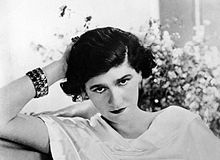Paul Iribe
Their modernist style, informed by both the vitality of the revolutionary art movements of the era, and by the flat planes and minimalism identified with Japanese painting served to revitalize the popularity of the fashion plate.
[2] Iribe's work is primarily distinguished by the illustrations he executed for style journals such as La Gazette du Bon Ton where his charming vignettes of the latest modes helped promote the designs of couturiers such as Paul Poiret.
[2] Iribe favored the liberal display of fluid forms, more in concordance with the design elements which were the hallmark of the Art Nouveau movement—poufs, lamé textiles; walls hung with tapestries, and carpeted floors.
The collection, executed exclusively in diamonds and platinum, was exhibited for public viewing and drew a large audience; some three thousand attendees were recorded in a one-month period.
[3] The couturier Paul Poiret recognized Iribe's talent and brought him in to create drawings, which would compellingly represent the new models in his collection.
The book created a controversy, as Poiret's design aesthetic promoted clothing with a relaxed line, emphatically denouncing the corseted look so long in vogue as the mandated female silhouette.
[5] In 1924 Iribe was given free rein in a film project for which he was director, set designer and costumer, Changing Husbands starring Leatrice Joy.
The New York Times gave it a scathing review, calling the film absurd, and the direction “amateurish.”[6] Iribe was a man prone to anger, shouting matches, and fist fights when contradicted and did not endear himself to colleagues.
His wife Maybelle gave him his own design establishment dedicated to the decorative arts located on the fashionable Rue du Faubourg Saint-Honoré.
[9] Signing his work “Jim,” a caricature drawn by the then unknown Jean Cocteau was published in Le Témoin In 1910; his likeness of actress Sarah Bernhardt was well received and brought him instant recognition.
[10] The drawings, political polemics, featured the identifiable likeness of Iribe's lover Coco Chanel re-imagined as the iconic symbol of French liberty, Marianne.
One such rendering shows Marianne (Chanel) being subjected to trial and sentence by a court of world leaders, Neville Chamberlain of Great Britain, Adolf Hitler of Germany, Benito Mussolini of Italy, and Franklin Roosevelt of The United States.
In a stage production of “Le Cadet des Courtas" the same year, she wore a piece of jewelry Iribe had designed in 1910, a luxury turban brooch shaped as an aigrette and inlaid with emerald and pearl.
[15] Iribe was with Coco Chanel, at her villa, La Pausa, on the French Riviera, on September 21, 1935, when he suddenly collapsed and died while playing tennis.



